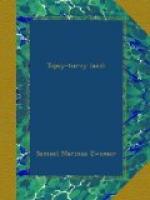“For thousands and thousands
who wander and fall,
Never heard of
that heavenly home;
I should like them to know
there is room for them all,
And that Jesus
has bid them to come.
I long for the joy of that
glorious time,
The sweetest and
brightest and best,
When the dear little children
of every clime
Shall crowd to
His arms and be blest.”
VII
DATES AND SUGAR-CANE
This is the sweetest chapter in the book. The pictures are enough to make one’s mouth water and give one an appetite for Arabian dates. I do not suppose there is a boy or girl in England or America that has not eaten the fruit of the Arabian palm tree; but how many of you know the taste of sugar-cane?
In many parts of Arabia, especially at Busrah and along the river Tigris, you can see the sugar-cane sellers sit by the wayside and dispose of this Arabian stick-candy to the boys and girls in exchange for coppers. The woman in the picture has chosen the shelter of a date tree and beside the tall bundles of cane she has oranges for sale as well. The sugar-cane is cut into pieces and sold “by the knot”; that is, by the length of the stick from one knot to the next. It is not expensive and I have seen even the very poorest children suck their cane on the way home as happy as sugar can make them. The sugar-cane is a kind of grass but it grows to twice the height of a boy and is over two inches in circumference. The stems are smooth, shining and hard on the outside, but inside they are porous and the pores are full of sugar sap. The sugar-cane first came from India, but the Arabs spread its cultivation as far as Morocco and Sicily; so that it is no wonder that the word “sugar” itself comes from the Arabic. Yet it shows how ignorant the Arabs are to-day because, although they have sugar-cane, their sugar nearly all comes from Europe. They do not know how to manufacture it and therefore eat the sugar-cane raw.
[Illustration: WOMAN SELLING SUGAR-CANE.]
Sweeter than sugar-cane and much more plentiful is the date. There is no place in all Arabia where you do not see the date palm growing, and seldom can you eat a meal in any part of the country but dates are part of the bill-of-fare. In fact thousands of people in Arabia have nothing but dates to eat from January to December! So plentiful are they that even donkeys and camels are fed on dates in some districts.
Many of the dates you buy in your own country come from Arabia. On the best kind of dates which come in wooden boxes you will find Muscat or Busrah stamped to show from what place they were shipped. There are very many kinds of dates in Arabia, and only a very few sorts are sent abroad. Some of them are too delicate to stand the long voyage and others are found only in small quantities. I do not think any of the dates that reach America equal those we pick from the palm tree ourselves here in Arabia—no more than dried apple rings taste as good as ripe juicy sweet apples from the orchard. When the dates ripen in September they are picked, sorted, and then packed in layers by the Arab women and boys who get paid for this work. Large steamships are loaded down with these boxes and many of them leave Busrah every year with no other cargo than dates.




